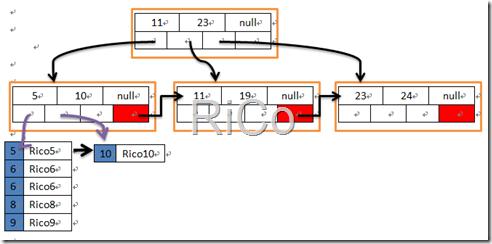[SQL SERVER]Bw(Buzz Word)- Tree 筆記
這篇我筆記 Bw-Tree 如何為in-memory帶來重大改善。
Bw-Tree 優點
1.針對範圍(range)和指標(point)搜尋有很高效率
2.自我平衡
3.每張 page 透過邏輯指標互相串起來
4.依照Key有順序存取
5.更有效率使用多CPU
這篇我會圍繞在Bw-tree Layer和Cache Layer。
Bw-Tree結構和b-tree結構類似,所有的leaf node依然還是資料頁(data page),
不同的是所有leaf level都有一個指標(類似hash index 的bucket_count),
其他index node只存放key(有順序)和下一頁指標
如此反覆處理直到在leaf node找到資料為止。
當要新增一筆資料(c1)到in-memory table時(假設該資料表有一hash index(c1)),
這時會擷取c1 value 並執行hash function,運算後會返回一個範圍值(依照該資料表上 bucket_count 定義),
而該值(記憶體指標)將會被存放在一個對應表(Mapping Table)中,
由於每張 page都是使用邏輯指標(page identifiers or PID)串再一起,
最後透過該指標轉換指向資料所存放的物理位置,整個過程大概如下
Bw-tree ==> Mapping Table ==> Physical Page
由於每一次新增相同值,且經過hash function運算後都會得到相同結果,
所以相同結果都會被群組再一起(這可說大大節省了記憶體開銷)
透過這樣的儲存機制,當要改變一個page物理位置時,
只需改變所對應的Mapping Table,所以整個Bw-tree存取路徑並不會改變,
下面我簡單驗證一下Bw-tree 架構如何大大節省記憶體開銷。
--一般資料表
drop table disktbl
create table disktbl
(
id int NOT NULL,
col1 varchar(100) COLLATE French_BIN2 NOT NULL INDEX idx1 NONCLUSTERED,
CONSTRAINT PK_disktbl PRIMARY KEY NONCLUSTERED (id)
)
DECLARE @step INT
SET @step = 1
WHILE @step <= 100000
BEGIN
INSERT INTO dbo.disktbl
VALUES (@step, 'rico1'),
(@step+1, 'rico2'),
(@step+2, 'rico3'),
(@step+3, 'rico4'),
(@step+4, 'rico5')
SET @step = @step + 5
END
--查看索引所使用大小
SELECT
o.name as table_name,
i.[name] AS IndexName,
i.type_desc,
s.used_page_count
,SUM(s.[used_page_count]) * 8 AS IndexSizeKB
FROM sys.dm_db_partition_stats AS s
INNER JOIN sys.indexes AS i ON s.[object_id] = i.[object_id]
AND s.[index_id] = i.[index_id]
INNER join sys.objects as o on o.object_id = i.object_id
where o.name='disktbl' and i.name='idx1'
GROUP BY o.name,i.[name],i.type_desc,s.used_page_count
idx1約使用4720 KB,pages:590
--in-memory 資料表
drop table memorytbl
CREATE TABLE memorytbl
(
id int NOT NULL,
col1 varchar(100) COLLATE French_BIN2 NOT NULL INDEX idx1 NONCLUSTERED,
CONSTRAINT PK_mytest PRIMARY KEY NONCLUSTERED HASH (id) WITH (BUCKET_COUNT = 150000)
) WITH (MEMORY_OPTIMIZED = ON, DURABILITY = SCHEMA_AND_DATA)
--新增10萬筆資料
DECLARE @step INT
SET @step = 1
WHILE @step <= 100000
BEGIN
INSERT INTO dbo.memorytbl
VALUES (@step, 'rico1'),
(@step+1, 'rico2'),
(@step+2, 'rico3'),
(@step+3, 'rico4'),
(@step+4, 'rico5')
SET @step = @step + 5
END
--查看索引所使用大小
select
o.name as table_name,
i.name as index_name,
xmc.memory_consumer_desc,
xmc.allocated_bytes / 1024 as allocated_kb,
xmc.used_bytes
from sys.dm_db_xtp_memory_consumers as xmc
join sys.indexes as i
on xmc.object_id = i.object_id
and xmc.index_id = i.index_id
join sys.objects as o
on o.object_id = i.object_id
where i.name = 'idx1';只使用952 bytes
--查看索引所使用page
in-memory 資料表
select
o.name as table_name,
i.name as index_name,
nis.internal_pages,
nis.delta_pages,
nis.leaf_pages
from sys.dm_db_xtp_nonclustered_index_stats as nis
join sys.objects as o
on o.object_id = nis.object_id
join sys.indexes as i
on i.object_id = nis.object_id
and i.index_id = nis.index_id
where i.name = 'idx1'; leaf_pages:1, delta_pages:5
note:
internal_pages:表示root和nonleaf page
delta_pages:該page比較特別,只存放資料操作(insert、delete)和記憶體值,
該記憶體值將永遠指向最近異動的資料。
可以看到Bw-tree所使用的page數量和空間大小都來的更小,
以前B-tree是資料表中每筆資料都存放指標,
假如你有一百萬筆資料,但索引鍵值資料內容都相同(如"rico"),
這時索引依然會需要1百萬筆指標,相對造成需要更多的page來存放,
而BW-tree不在這樣存放,和B-tree最大不同是會把相同index value(經過hash function)群組起來並串再一起,
所以索引中不需要1百萬筆指標。
參考
http://research.microsoft.com/pubs/178758/bw-tree-icde2013-final.pdf
SQL Server Hekaton In-memory tables: Understanding the Row Chains of Hash Indexes
SQL Server Hekaton (XTP) in-memory Tables: Range Indexes and Row Chains





